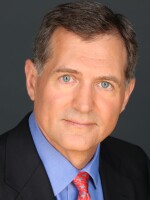George Washington set the precedent for many presidential traditions, including funerals. He was buried in a modest, private ceremony at his Mt. Vernon estate in Virginia.
"The expectation was that in retirement presidents returned to their private lives and that would then dictate where they were buried," said Matt Costello, the senior historian with the White House Historical Association, a private group that works closely with the White House.
"There's very much this older tradition of presidents being buried on family properties, near family properties, and a lot of the funeral arrangements are handled by family members," he said.
Today, presidential funerals are meticulously planned years in advance by a large military task force that works closely with the government and the ex-president's family.
George H.W. Bush's body is being flown from Houston to Washington, and he will lie in state in the Rotunda of the U.S. Capitol from Monday afternoon to Wednesday morning. This will be followed by a funeral service at the Washington National Cathedral. And then his body will be flown back to Texas for another service before burial on Thursday.
These funerals also bring together that very elite club of ex-presidents.
"There's only a few people walking the face of the earth that understand the pressures, the anxieties, the circumstances, the challenges that you're going to face in that office," said Costello.
At the last funeral for an ex-president, that of Gerald Ford in 2007, George H.W. Bush gave a eulogy, saying Ford brought the country together after the Watergate scandal in the 1970s.
"History has a way of matching man and moment," Bush said. "His presidency will be remembered as a time of healing in our land."
Partisan differences melt away. Democrat Bill Clinton spoke at the 1994 service for Republican Richard Nixon, saying he should be remembered for the totality of his career, not just Watergate, and praising his foreign policy insights.
"For the past year, even in the final weeks of his life, he gave me his wise counsel, especially with regard to Russia," Clinton said.

Lincoln's funeral
One of the first truly national funerals took place when Abraham Lincoln was assassinated in Washington in 1865.
His body was taken on a train ride covering some 1,700 miles to his home of Springfield, Illinois. The route largely retraced — in the opposite direction — the trip Lincoln made in 1861 after he was elected president and made his way to Washington.
"All along the way, in every major city, the funeral train would stop. There would be a massive funeral procession," said Louis Picone, the author of the book, The President Is Dead, which recounts the funerals of all the deceased presidents. "Citizens would line up they'd wait for hours sometimes hundreds of thousands of people would line up to pass by the coffin."
It got even more complicated once Lincoln's body reached Springfield. He was buried — and reburied — many times before he was finally placed in his current tomb.
"Historians really lose track of how many times his body was moved over the years," Picone added. "It's a ballpark of about 15 times that his coffin was moved."
The last president to die in office was John F. Kennedy. His 1963 assassination traumatized the country.
"This was the first state funeral that was on television, so you had something like 90 to 95 percent of Americans tuned in to watch the funeral," said Costello.
Kennedy was buried at Arlington National Cemetery with an eternal flame at his grave, an iconic image to this day.
But a presidential burial there is a real exception. William Howard Taft is the only other ex-president buried at Arlington, which is just across the Potomac River from Washington.
Just one ex-president, Woodrow Wilson, is buried in Washington. He was laid to rest at the National Cathedral.
Costello noted there's been a new trend in recent decades, with former presidents choosing to be buried at their presidential libraries. This holds for George H.W. Bush as well. He will be buried next to his wife Barbara, who died in April, at his presidential library in College Station, Texas.
Copyright 2022 NPR. To see more, visit https://www.npr.org.







